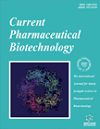Current Pharmaceutical Biotechnology - Volume 3, Issue 1, 2002
Volume 3, Issue 1, 2002
-
-
Phage Display as a Tool for Protease Ligand Discovery
More LessBy A.E. NixonProteolytic enzymes have been implicated as the pathological agent in a number of disease states. For this reason proteases are attractive therapeutic targets. Phage display of peptide libraries can be used to identify peptides that may be used either directly as inhibitors or serve as leads in the generation of prodrugs and peptidomimetics.
-
-
-
Direct Selection of cDNAs from Filamentous Phage Surface Display Libraries: Potential and Limitations
More LessAuthors: C. Rhyner, R. Kodzius and R. CrameriOver the past decade, powerful technologies devoted to survey large molecular libraries for the presence of specific clones using the discriminative power of affinity selection have been developed. Phage surface display technology is the most established of these methods and has revolutionised our ability to select agonistic and antagonistic peptides, antibodies with desired specificity and other drug targets. Thereby ligands are expressed as fusions to phage coat proteins and their respective genes are packaged within the phage. The basic concept of linking the phenotype, expressed as gene product displayed on the phage coat, to its genetic information integrated into the phage genome, creates fusion proteins covalently associated with the infectious particle itself. Binding of the phage to the target molecule offers a selective system by which rare phage carrying the desired gene product can be selected from large phage populations carrying inappropriate sequences. Phage selected in this fashion can be used for subsequent rounds of selection because they are able to self-replicate in suitable host cells, yielding target-specific phage populations after several consecutive rounds of affinity selection. Over 1500 publications describe the use of phage display technology highlighting its performance. Phage display possesses certain limitations, including its use for selection of genes from cDNA libraries that has lagged behind, despite the many accomplishments of this technology. Here we discuss recent progress in construction and screening of cDNA libraries displayed on phage surface and emerging concepts allowing fast identification of virtually all different clones present in enriched libraries.
-
-
-
Bacteriophage Lambda as a Vehicle for Peptide and Protein Display
More LessBy R.H. HoessBacteriophage lambda has emerged as an alternative vehicle for the surface display of peptides and proteins to the commonly used filamentous phage. There are a number of unique features that make lambda an attractive display vehicle including the ability to display multimeric proteins, no requirement for secretion of the displayed fusion protein and the means to vary the valency of the displayed fusion protein. With its increasing use for cDNA encoded display, the lambda display systems will be an important tool for functional genomics.
-
-
-
Application of Phage Display Technology to Cancer Research
More LessDespite years of international effort, cancer remains a major cause of death in developed countries, claiming more than 500 000 lives per year in the United States alone. Recombinant DNA technology and high throughput screening methods have recently increased the pace of cancer research. In this review, we will examine the impact and contribution of phage display technology to this area of research. As a biological combinatorial system, the strength of phage display lies in its flexibility and its ability to efficiently study protein-protein interactions. The technology has also facilitated the discovery of molecules that have potential roles in the diagnosis and treatment of cancer.
-
-
-
Evolving Phage Vectors for Cell Targeted Gene Delivery
More LessAuthors: D. Larocca, M.A. Brug, K. Jensen-pergakes, E. Ravey, A. Gonzalez and A. BairdWe adapted filamentous phage vectors for targeted gene delivery to mammalian cells by inserting a mammalian reporter gene expression cassette (GFP) into the vector backbone and fusing the pIII coat protein to a cell targeting ligand (i.e. FGF2, EGF). Like transfection with animal viral vectors, targeted phage gene delivery is concentration, time, and ligand dependent. Importantly, targeted phage particles are specific for the appropriate target cell surface receptor. Phage have distinct advantages over existing gene therapy vectors because they are simple, economical to produce at high titer, have no intrinsic tropism for mammalian cells, and are relatively simple to genetically modify and evolve. Initially transduction by targeted phage particles was low resulting in foreign gene expression in 1-2 percent of transfected cells. We increased transduction efficiency by modifying both the transfection protocol and vector design. For example, we stabilized the display of the targeting ligand to create multivalent phagemid-based vectors with transduction efficiencies of up to 45 percent in certain cell lines when combined with genotoxic treatment. Taken together, these studies establish that the efficiency of phage-mediated gene transfer can be significantly improved through genetic modification. We are currently evolving phage vectors
-
Volumes & issues
-
Volume 26 (2025)
-
Volume 25 (2024)
-
Volume 24 (2023)
-
Volume 23 (2022)
-
Volume 22 (2021)
-
Volume 21 (2020)
-
Volume 20 (2019)
-
Volume 19 (2018)
-
Volume 18 (2017)
-
Volume 17 (2016)
-
Volume 16 (2015)
-
Volume 15 (2014)
-
Volume 14 (2013)
-
Volume 13 (2012)
-
Volume 12 (2011)
-
Volume 11 (2010)
-
Volume 10 (2009)
-
Volume 9 (2008)
-
Volume 8 (2007)
-
Volume 7 (2006)
-
Volume 6 (2005)
-
Volume 5 (2004)
-
Volume 4 (2003)
-
Volume 3 (2002)
-
Volume 2 (2001)
-
Volume 1 (2000)
Most Read This Month


